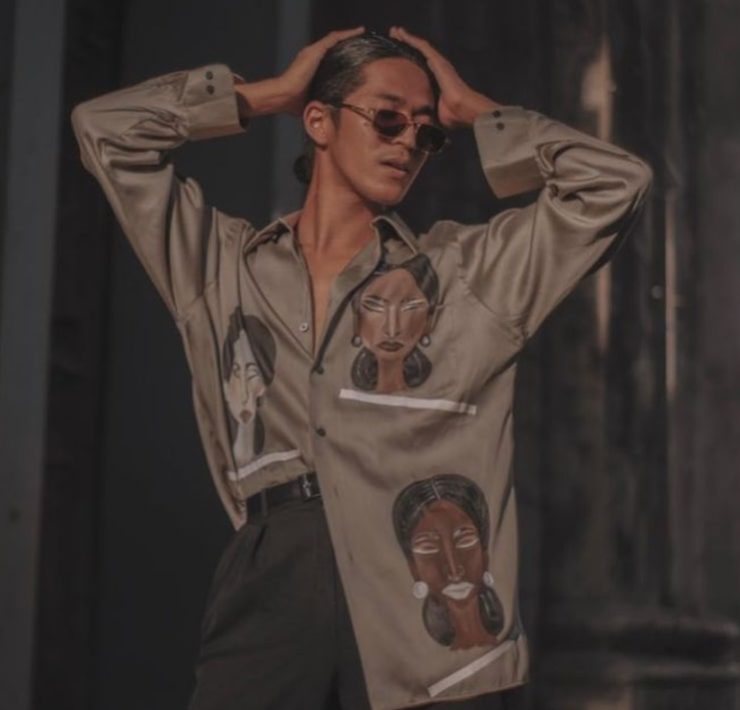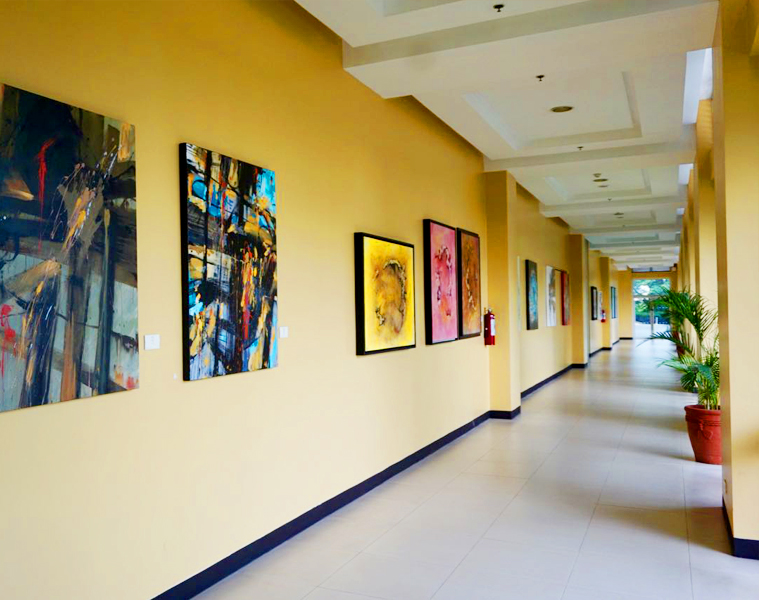The long journey (and the nitty-gritty) behind the opening of ArtInformal’s second gallery in Makati

Much has been written about the clean and minimalist appeal of ArtInformal Gallery’s second branch in Makati. AI2, as it is referred to (the original ArtInformal Gallery in Greenhills would be AI1), has been praised for its pristine white walls and concrete flooring—a Jagnus Design Studio-conceived setting that is meant to put the spotlight (this one designed and set up by WE Design creative director Mark Wilson) on the art.

When we visited the gallery last Thursday, however, there were no artworks on the wall and the place was far from serene: everyone at AI2 was elbows deep in preparation for the gallery’s second show, a three–exhibit presentation that features the artists Mark Valenzuela (Cheap Tricks), Angelica Harris-Faull (My flesh whispers an urgent story), and Alycia Bennett (Buy 1 Take 1, together with Valenzuela). There was welding going on in the second exhibition hall, and the office at the first floor was cluttered with framed artworks that are yet to be hung.
The show, by the way, opened two days later, March 17.

ArtInformal founder and creative director Tina Fernandez seemed to take it all in stride, though, or at least be resigned to the stress of having everything come together at the last minute. “[The artworks for] this exhibit should have been installed by today, pero wala,” she complained good-naturedly. “I always say I’m used to the stress of putting together a show, but in truth, I’m not. I still panic.”
The emotional business of art
It’s quite the feat to still feel anxiety before an exhibit, given that AI1 was established in 2004. But Fernandez admits that working for nearly 15 years in the gallery business brings its own cycles of alternating inspiration and what she describes as “the feeling of being in a limbo”—a state that almost kept AI2 from coming into being.

Case in point: In 2015, when Mara Coson first offered her space for a second ArtInformal Gallery at what eventually became The Alley at Karrivin, Fernandez was experiencing a profound lack of motivation. “I was kind of lost, kind of sick and tired of the gallery business,” she admitted. “I go through stages where I’m ganado, then there are stages where I don’t feel like doing this anymore, usually whenever I get too emotionally involved with the work. I’d go, ‘You know what? F*ck it, bahala na, ayoko na!‘ I had to tell Mara sorry, because it wasn’t the right time for me to even think about investing in a new gallery.”
Worried about her loss of interest in and even taste for art (“I didn’t like any artwork I’d see, across the board”), she asked help from a therapist who recommended that she attend a Carl Jung workshop about understanding one’s self through personality archetypes, including those from Greek mythology. Fernandez followed the advice, “and on the second day of that workshop, a light bulb just went on in my head. I knew exactly what I wanted to do.” She immediately got in touch with Coson, months after she had rejected the latter’s initial offer, to inquire about any available space left in Karrivin Plaza. It still wasn’t for AI2 at that point, though. Rather, it was for Aphro Living Art & Design, the 126 sq.m. gallery/furniture and curios store that was also designed by Jagnus Design Studio.

“Once I realized certain things about myself and why I go through cycle of losing interest in things I usually love, I got to understand how I could keep that from happening, or at least how to react should it happen again,” Fernandez reflected. Through the workshop, she discovered that her female archetype is Aphrodite—hence Aphro—and her male archetype is Zeus. “That’s why the place has these giant stairs; it’s meant to look like a temple.”

“Always something new”
People may scoff at the New Age-y idea of believing in archetypes, but Fernandez’s light bulb moment makes a very good case of picking up a valuable lesson from it. As the goddess of love and beauty, Aphrodite has the enviable (if a touch self-deceiving) capability to be “reborn” at the end of every love affair or sexual encounter. “After she makes love to a man or a god, she goes back into the sea and comes back up as if she were a virgin again,” Fernandez explains. It’s a self-sustaining form of the replenishment of love, desire, sexual attraction, and all the other values that the goddess holds in power, a replenishment that Fernandez saw as something she could do for herself.
This is reflected in Aphro’s display and the many, many pieces it features, which foster the promise of infinite creative possibilities. Opened in 2016, it is Fernandez’s happy place. “Whenever I’m going through the emotional stress of working in the gallery, I go there, and immediately feel better. I may still be dealing with the same artist, but at Aphro, it would be under different circumstances; there’s an automatic change in temperament.” That change isn’t just with Fernandez but also with the creatives she deals with. “Some of the artists like hanging out at Aphro and they’d ask if they could do something for the place. ‘Ang ganda ng ginawa mo dito,’ they’d say, and they’d offer some of the pieces they created in their studios simply out of fun—pieces that they could never put on exhibit kasi naglalaro lang sila nung ginawa nila ‘yun.
“So the stuff we have with Aphro are mostly one of a kind. When people go there and see something they like, I tell them to buy it immediately, because it might not be there anymore the next time they visit; something else would be on display.”
“Picture a musical production. When you’re in the audience and you watch the performance, you’re amazed by the spectacle, but you’re not aware of a bigger production crew behind the curtain who has been working to make sure everything goes well. That’s what people don’t see: The difficulty in producing even a very simple show.”
And then there was AI2
It had been barely a year since Aphro opened when Coson approached Fernandez with yet another offer of available space. This time, it was a 412 sq. m. two-story space that used to house a dance studio and a recruitment agency. “I said to her, ‘Wait, I haven’t recovered financially yet from Aphro!’” Fernandez recalled with a laugh. “She said it was up to me, that I have the right to first refusal, so I thought, ‘Sige na, bahala na!’”
AI2 officially opened on February 15 with an all-women show featuring solo exhibitions from artists Brisa Amir, Tosha Albor, and Christina Dy. Its second show, the one that opened on March 17, will run until April 14. “The shows here in our Makati gallery run for about a month,” Fernandez acknowledged. “With our Greenhills gallery, I want to give people who live in the south, who don’t get to trek too often to Greenhills, more chances to visit there whenever they have free time, so the shows there run for two months.”

Another difference between the two galleries are how their respective shows are produced. “Our program here at AI2 is actually lifted from the AI1 program; I just transferred it here. We have three exhibition spaces here in Makati so our chosen artists can have solo shows,” Fernandez explained. “In Greenhills naman, the shows are curator-based. There, I want powerful exhibits of various artists that were put together by a single curator with a strong concept. I plan our shows two years in advance.”
Two galleries, two different show cycles. It can get exhausting, even to someone who has been working in the art world as long as Fernandez has, and she acknowledges the work that her staff puts in to pull everything together. “It is hectic, but I’m lucky to have good team. They work behind the scenes and do things that collectors, viewers of art, and even artists don’t see.

“People don’t realize how complicated gallery operations are,” she continued. “It’s not just a matter of hanging artworks on the walls and calling that a show. A lot of preparation and communication go on between the artists and our staff who oversee the operations. Plus, different artists have different personalities and different work habits that we have to adjust to.” She waved in the direction of the welding that was going on in the next hall. “Some artists are used to getting things done at the last minute, insisting na ‘Kaya ‘yan!‘ Yes, kaya nila, pero kami [the gallery], hindi, because we have to document the artworks properly and photograph them before a show opens. I also have to approach my loyal collectors before the show and present 3D images to them, because we have to sell to keep the gallery going.”
The necessity of galleries
Fernandez brought up a time in the local arts scene when galleries were closing one by one. “This was in the ’80s. Artists had begun selling directly to collectors then, who would comment, ‘Ang laki pala ng percentage na nakukuha ng gallery [in a sale]. I’ll buy directly from you instead.'” But, as she reasoned, putting together a show costs a lot of money, hence the necessity of a sizable cut. “Our overhead each month at AI1 is at least half a million. Attending an art fair abroad and bringing an artist with us easily cost us P3.5 million. So what happens na when we don’t sell?”

She pointed out the consequence of having galleries close shop: “The artists eventually become invisible.” While there are people who are capable of patronizing an artist’s career, it’s reasonable not to expect them to provide this financial support all throughout their lives. “Also, after a while, there’ll be a new name that they might like more, so sorry na lang to the artist that gets left behind, right? No gallery will then accept them they know that they sell directly to buyers.”
The benefits of being part of a community
Despite the headaches (and heartaches) that running two galleries inevitably brings, it is Fernandez’s drive to show local audiences something they might not have seen before that keeps her in the business, with a healthy dose of self-care thrown in, of course. There is something about being part of the Karrivin neighborhood, though, that adds another layer of inspiration.
“It’s nice to be part of a community where people get along well like family,” she said. “Work is something that you should love to do, and it’s such a bonus if your neighbors also become your family.” Aside from their similar aesthetics that give The Alley a strong, cohesive overall look, the folks behind the shops and establishments at the Karrivin Plaza share similar values, such as love for animals (evidenced by the obviously well-loved cats lounging around in the common areas) and the appreciation of greenery. “We hang out socially, and when they saw the backroom of the gallery, they declared it to be the new hangout space for drinking after work,” Fernandez shared with a laugh. “That’s why there’s a bar here.”

As for what AI2 contributes in return to the community, aside from a really nice place to chill in, she said, “The people here appreciate art, but I think the community that we have here would not pay so much attention to it if it weren’t for our relationship. They come here to the gallery because of that relationship. People go around and look at artworks, and when they see something they like, they purchase it. Maybe they’d feel intimidated in another a gallery, but here, they feel comfortable talking to me about the works they like and even the kind of art they don’t like. I’d like to think that the community here wouldn’t have become this much closer to art if AI2 weren’t here.”
After the long, bumpy, emotionally, and mentally taxing road it took to finally have AI2 up and running, it is nice to see everything come together in the end and Fernandez able to enjoy the results of all the work she has put in. But then again, the work never ends; there’s always the next exhibit, and then the next one, and then the next one, and all of the people she has to deal with every time. “Ewan ko ba,” she concluded, but with a smile on her face. “I think I need to attend another workshop kasi parang I need a refresher course!”
ArtInformal Makati is located at The Alley At Karrivin Plaza, 2316 Chino Roces Avenue Extension, Makati City. ArtInformal Greenhills is located at 227 Connecticut St., Greenhills East, Mandaluyong City. To learn about both galleries’ ongoing and upcoming shows, visit the ArtInformal website.















